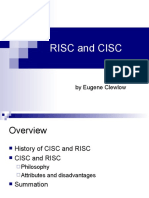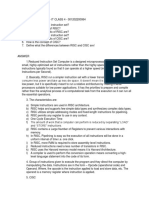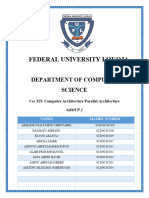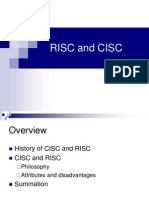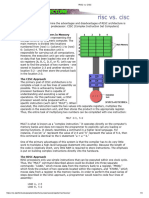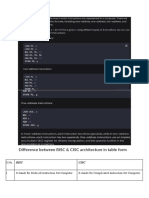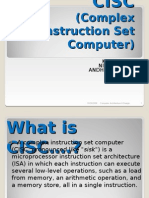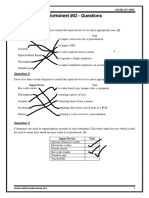15.1 Processors & Paralell Processing (MT-L)
15.1 Processors & Paralell Processing (MT-L)
Uploaded by
MR.VCopyright:
Available Formats
15.1 Processors & Paralell Processing (MT-L)
15.1 Processors & Paralell Processing (MT-L)
Uploaded by
MR.VCopyright
Available Formats
Share this document
Did you find this document useful?
Is this content inappropriate?
Copyright:
Available Formats
15.1 Processors & Paralell Processing (MT-L)
15.1 Processors & Paralell Processing (MT-L)
Uploaded by
MR.VCopyright:
Available Formats
Computer Science 9618
P3: (15.1 Processors & Parallel processing) with Majid Tahir
Syllabus Content:
15.1 RISC & CISC processors
show understanding of the differences between RISC and CISC processors
Notes and guidance
o difference between RISC & CISC processors
o understanding of interrupt handling on CISC and RISC processors
o importance of pipelining and registers in RISC processors
15.1 Parallel processing
show awareness of the four basic computer architectures:
Notes and guidance
o SISD, SIMD, MISD, MIMD
o show awareness of the characteristics of massively parallel computers
3.3.5 RISC Processors:
Background to RISC
Short for Reduced Instruction Set Computing. The diagram below shows the RISC approach
taken to processor design.
Reduced Instruction Set Computer RISC processors were first developed in early 1980s. Their
development however has been slowed by:
the lack of software which is written to run on RISC processor
Intel’s dominance in PC computer market using the family of x86 processors
The home is likely to have many RISC-based processor devices. This includes Nintendo Wii,
Microsoft Xbox 360, Sony PlayStation 3, Nintendo DS and many televisions and
smartphones.
www.majidtahir.com Contact: +923004003666 Email: majidtahir61@gmail.com 1
Computer Science 9618
P3: (15.1 Processors & Parallel processing) with Majid Tahir
However the desktop PC is likely to have a non-RISC processor. The reason of this is that
moving to a new RISC instruction set in the processor would mean that all the existing software
would no longer work.
The assembly language we studies earlier assumed that processor architecture has only one
general-purpose register, the Accumulator. This is simplified scenario as PC processors
generally have around have eight general-purpose registers.
The number of basic machine instructions would be several hundred. These computers were
known as Complex Instruction Set Computers (CISC). The large numbers of instructions
were matched closely to the hardware of the processor and the structures used in high level
language program code.
CISC and RISC processors
The 'architecture' of a processor can be defined in a number of ways. From the point of view of
a sophisticated programmer, the architecture involves the following:
the instruction set
the instruction format
the addressing modes
the registers accessible by instructions.
The choice of the instruction set is the main factor in deciding on a suitable architecture. One
view is that the instruction set should be chosen so that it can be clearly applied to important
problems, that only simple equipment is required and that important problems are handled
speedily.
An opposing view is that it should be chosen to suit the needs of high-level languages.
www.majidtahir.com Contact: +923004003666 Email: majidtahir61@gmail.com 2
Computer Science 9618
P3: (15.1 Processors & Parallel processing) with Majid Tahir
Early developments in computing led to the latter view becoming dominant. Computer systems
contained what would now be referred to as CISC (Complex Instruction Set Computers)
processors with the complexity increasing with the advent of new systems.
However, the philosophy began to be challenged in the late 1970s. It was argued that RISC
(Reduced Instruction Set Computers) would be a better approach. Table below contains a
number of features that distinguish RISC from CISC.
It can be seen that 'reduced' affects more than just the number of instructions.
The simplicity of the instructions allows data to be stored in registers and manipulated in them
with no resource to memory access other than that necessary for initial loading and possible
final storing. The simplicity also allows hard-wiring inside the control unit with limited complexity
required.
Comparison of CISC and RISC
RISC CISC
Fewer instructions More instructions
(Each instruction takes exactly one clock (Clock cycles taken by instruction may vary)
cycle)
Simpler instructions Complex instructions
Small number of instruction formats Many instruction formats
Single-cycle instructions whenever possible Multi-cycle instructions
Fixed-length instructions Variable-length instructions
Only load and store instructions to address Many types of instructions to address memory
memory
Fewer addressing modes More addressing modes
Multiple register sets Fewer registers
(Large number of General-purpose registers) (Limited number of General-purpose registers)
Hard-wired control unit Micro-programmed control unit
Pipelining easier Pipelining more difficult
Instructions and data held in RAM Extensive use made of Cache Memory
The design emphasis is on the software The design emphasis is on the hardware
Processor chips require fewer transistors Uses the memory unit to allow complex
instructions to be carried out
In contrast, the specialised instructions that can be part of CISC architecture often require repeated
memory access.
The complexity of some of the instructions makes hard-wiring extremely difficult so
microprogramming is the norm.
Hardwired control unit: Hardwired control units are implemented through use of combinational
logic units, featuring a finite number of gates that can generate specific results based on the
instructions that were used to invoke those responses. No ROM inside CU and no
microprogramming available. Hardwired control units are generally faster than micro-
programmed designs.
www.majidtahir.com Contact: +923004003666 Email: majidtahir61@gmail.com 3
Computer Science 9618
P3: (15.1 Processors & Parallel processing) with Majid Tahir
A comparison of two processors is shown in Table below
Intel 80486 (CISC) Sun SPARC (RISC)
Number of instructions 235 69
Instruction size (bytes) Between 1 and 11 4
Addressing modes 11 1
General-purpose registers 8 520
However, the increased complexity of instructions for CISC is often because they more closely
match high-level language constructs. This means that compiler writing becomes much easier
for a CISC processor.
One of the major driving forces for creating RISC processors was the opportunity they would
provide for efficient pipelining.
Pipelining:
Pipelining is an implementation technique where multiple instructions are overlapped in
execution.
Pipelining is a technique used to improve the execution throughput of a CPU by using the
processor resources in a more efficient manner.
The basic idea is to split the processor instructions into a series of small independent stages.
Each stage is designed to perform a certain part of the instruction. At a very basic level, these
stages can be broken down into:
(IF) Instruction Fetch: Fetches an instruction from memory
(ID) Instruction Decode: Decodes the instruction be executed
(IE) Instruction Execute: Executes the instruction
(IW) Instruction Write: Writes the result back to register or memory
www.majidtahir.com Contact: +923004003666 Email: majidtahir61@gmail.com 4
Computer Science 9618
P3: (15.1 Processors & Parallel processing) with Majid Tahir
There will be a dedicated CPU module for each of the stages mentioned above. Blue boxes are
for 1st instruction and Red boxes are for second instructions.
In a non-pipelined CPU, when an instruction is being processed at a particular stage, the other
stages are at an idle state – which is very inefficient. If you look at the diagram, when the 1st
instruction is being decoded, the Fetch, Execute and Write Units of the CPU are not being used
and it takes 8 clock cycles to execute the 2 instructions.
The underlying principle of pipelining is that the fetch-decode-execute cycle can be separated
into a number of stages. One possibility is a five-stage model consisting of:
1. instruction fetch (IF)
2. instruction decode (ID)
3. operand fetch (OF)
4. instruction execute (IE)
5. result write back (WB).
To demonstrate how pipelining works, we will consider a program which has six instructions (A,
B, C, D, E and F). Figure above shows the relationship between processor stages and the
number of required clock cycles when using pipelining. It shows how pipelining would be
implemented with each stage requiring one clock cycle to complete.
This functionality clearly requires processors with several registers to store each of the stages.
Execution of an instruction is split into a number of stages; as each stage completes, the
first stage of the first instruction can now be executed.
Then the second instruction can start execution before the first one has completed, and
so on, until all six instructions are processed.
In this example, by the time instruction ‘A’ has completed, instruction ‘F’ is at the first
stage and instructions ‘B’ to ‘E’ are at various in-between stages in the process. As Figure
shows, a number of instructions can be processed at the same time, and there is no need
to wait for an instruction to go through all five cycles before the next one can be
implemented.
In the example shown, the six instructions require 10 clock cycles to go to completion.
Without pipelining, it would require 30 (6 × 5) cycles to complete (since each of the six
instructions requires five stages for completion).
www.majidtahir.com Contact: +923004003666 Email: majidtahir61@gmail.com 5
Computer Science 9618
P3: (15.1 Processors & Parallel processing) with Majid Tahir
One issue that has to be dealt with regarding a pipelined processor is interrupt handling. The
discussion in Chapter 5 referred to a processor with instructions handled sequentially. In the
pipelined system described above there will be five instructions in the pipeline when an interrupt
occurs. One option for handling the interrupt is to erase the pipeline contents for the latest four
instructions to have entered. Then the normal interrupt-handling routine can be applied to the
remaining instruction.
The other option is to construct the individual units in the processor with individual program
counter registers. This allows current data to be stored for all of the instructions in the pipeline
while the interrupt is handled.
Problems with pipelining:
Two issues will cause the pipeline to stall:
dealing with a data dependency between instructions
branch instructions.
Data dependency:
Progress check
A program contains the following sequence of instructions:
//add the contents of R1 and R2;
store the result in R3
ADD R3, R1, R2
ADD R5, R4, R3
Explain the data dependency
here………………………………………………………………………………………..
………………………………………………………………………………………………………………
…………………………
………………………………………………………………………………………………………………
…………………………
The detail of pipelining of the two istructions is as follows:
When instruction 2 is at its Decode process, the processor will read the value of R3 and R4
Instruction 1 is one step ahead, so at this time the contents of R1 and R2 are being added,
but will not yet have been written to R3
Therefore the second instruction is unable to read the R3 value it needs.
The pipeline is stalled and loaded with a number of empty instructions called ‘bubbles’
One technique for dealing with data-dependent instructions is for them to be identified by the
compiler which will then attempt to re-order the instructions.
www.majidtahir.com Contact: +923004003666 Email: majidtahir61@gmail.com 6
Computer Science 9618
P3: (15.1 Processors & Parallel processing) with Majid Tahir
Branch instructions:
Consider the following sequence of instructions
Loop: ADD R3, R2, R1 // add R1 to R2 and store in R3
ADD R6, R5, R4 // add R4 to R5 and store in R6
JPE R3, R6, LOOP // compare R3 and R6 –if equal jump to address LOOP
The issue is same here as Progress check, the third instruction has to know the values in
Register R3 and R6. These are not known as neither instruction 1 or instruction 2 has yet written
the value to the register. This can cause the pipeline to stall.
One strategy that pipelining can use to deal with this branch prediction. The processor makes a
guess at the outcome of the condition Research has shown that if the branch instruction is at the
bottom of the loop, the execution will go back to the start of the loop in around 90% cases.
Conditions at the start of loop are true in 50% cases. Therefore the strategy is to assume the
condition is true in the first case and not true in the second case. If the guess proves to be wrong
then the processor must re-instate the register contents and start the pipeline again with correct
instructions.
Interrupt handling on CISC & RISC processors:
The use of interrupt on a RISC processor is no different. The same definition of an interrupt
holds: a signal sent to the processor from hardware device to indicate that device needs
attention.
The use of interrupts avoids the processor having to regularly check to see if a hardware device
needs its attention. This strategy (called pooling) was in use before interrupts.
The system uses vectored interrupts. Every device is assigned a device number that
corresponds to bits sent to an interrupt register. Hence from the number, the processor knows
the source of interrupt.
Once the interrupt is received, the state of all registers must be saved and the appropriate
interrupt service routine (ISR) code executed.
Parallel processing:
Parallel processing means that the architecture has more than one processor. Different
processors are responsible for different parts of tasks. The programmer must design the code so
that specific code is used for processing of the task’s component parts. Each task is then
processed by different processor. The software will integrate the data produced to provide the
final software solution
Four variants of parallel processing are:
SISD Single Instruction Single Data
SIMD Single Instruction Multiple Data
MISD Multiple Instruction Single Data
MIMD Multiple Instruction Multiple Data
www.majidtahir.com Contact: +923004003666 Email: majidtahir61@gmail.com 7
Computer Science 9618
P3: (15.1 Processors & Parallel processing) with Majid Tahir
SISD (Single Instruction Single Data stream):
SISD (Single Instruction Single Data stream) is the typical arrangement found in early personal
computers. There is a single processor with one data source which works on a single algorithm,
so no processor parallelism. The single data stream just means one memory.
Each task is processed in a sequential order. Since there is a single processor, this architecture
does not allow for parallel processing.
SIMD (Single Instruction Multiple Data stream):
SIMD (Single Instruction Multiple Data stream) describes how an array or vector processor
works.
SIMD (single instruction multiple data) uses many processors. Each processor executes the
same instruction but uses different data inputs – they are all doing the same calculations but on
different data at the same time.
SIMD are often referred to as array processors; they have a particular application in graphics
cards. For example, suppose the brightness of an image made up of 4000 pixels needs to be
increased. Since SIMD can work on many data items at the same time, 4000 small processors
(one per pixel) can each alter the brightness of each pixel by the same amount at the same time.
This means the whole of the image will have its brightness increased consistently. Other
applications include sound sampling – or any application where a large number of items need to
be altered by the same amount (since each processor is doing the same calculation on each
data item).
This is an appropriate architecture for problems which need to do an analysis of the large dataset
using the same criteria. The several processors each have its own local cache memory. This
makes possible a single program instruction which performs the same action simultaneously on
several data items.
MISD (Multiple Instruction Single Data stream):
Many processors perform operations on same data value. The data may be one value from an
array. One strategy for MISD is the parallel input of data value through a network of processor
www.majidtahir.com Contact: +923004003666 Email: majidtahir61@gmail.com 8
Computer Science 9618
P3: (15.1 Processors & Parallel processing) with Majid Tahir
nodes. The nodes (whose behavior is programmable with software) will merge or sort the data
values into final result.
MISD (multiple instruction single data) uses several processors. Each processor uses different
instructions but uses the same shared data source. MISD is not a commonly used architecture
(MIMD tends to be used instead). However, the American Space Shuttle flight control system did
make use of MISD processors
MIMD (Multiple Instruction Multiple Data stream):
MIMD (multiple instruction multiple data) uses multiple processors. Each one can take its
instructions independently, and each processor can use data from a separate data source (the
data source may be a single memory unit which has been suitably partitioned). The MIMD
architecture is used in multicore systems (for example, by super computers or in the architecture
of multi-core chips).
MIMD has examples in modern personal computers which are of the symmetric multiprocessor
type using identical processors. In this case, each processor executes a different individual
instruction. The multiple data stream can be provided by a single memory suitably partitioned.
Each processor might have a dedicated cache memory.
Characteristics of massively parallel computers
Parallel computer systems Examples of one type of multicomputer system are called massively
parallel computers. These are the systems used by large organisations for computations
involving highly complex mathematical processing. They are the latest in an evolution of what
have traditionally been called 'supercomputers'.
Massively parallel computers
www.majidtahir.com Contact: +923004003666 Email: majidtahir61@gmail.com 9
Computer Science 9618
P3: (15.1 Processors & Parallel processing) with Majid Tahir
The major difference in architecture is that instead of having a bus structure to support multiple
processors there is a network infrastructure to support multiple computer units. The programs
running on the different computers can communicate by passing messages using the network.
An alternative type of multicomputer system is cluster computing, where a very large number of
PCs are networked.
The processor from each computer forms part of a larger pseudo-parallel system which can act
like a super computer. Some textbooks and websites also refer to this as grid computing.
Massively parallel computers have evolved from the linking together of a number of computers,
effectively forming one machine with several thousand processors. This was driven by the need
to solve increasingly complex problems in the world of science and mathematics.
By linking computers (processors) together in this way, it massively increases the processing
power of the ‘single machine’. This is subtly different to cluster computers where each computer
(processor) remains largely independent. In massively parallel computers, each processor will
carry out part of the processing and communication between computers is achieved via
interconnected data pathways. Figure shows this simply.
www.majidtahir.com Contact: +923004003666 Email: majidtahir61@gmail.com 10
Computer Science 9618
P3: (15.1 Processors & Parallel processing) with Majid Tahir
Exam-style Questions
1 (a) Computer systems are now often constructed with RISC processors.
(i) State what the acronym RISC stands for. [1]
(ii) State four characteristics to be expected of a RISC system. [4]
(b) A RISC processor is likely to be 'hard-wired'.
i. Explain what this term means and which specific part of the processor will be hard-wired.
[3]
ii. State what the alternative to hard-wiring is and what hardware component is needed to
be part of the processor to allow this alternative to be implemented. [2]
2 (a) Parallelism can be achieved in a number of ways.
i. Identify three different types of parallelism. [3]
ii. Identify which type pipelining belongs to. [1]
iii. Using a diagram, explain how pipelining works. [5]
b. Interrupt handling is not so straightforward in a pipelined system. Explain why this is so and
give a brief account of how problems can be avoided. [3]
www.majidtahir.com Contact: +923004003666 Email: majidtahir61@gmail.com 11
Computer Science 9618
P3: (15.1 Processors & Parallel processing) with Majid Tahir
Progress answer:
The second instruction needs the value in register R3. If instruction1 has not completed, this
value will not be available to instruction 2.
Answer of exam style questions:
Exam-style Questions (with mark allocation in brackets)
References:
Computer Science Course Book by Sylvia Langfield & Dave Duddell
Cambridge international AS & A level by david Watson & Hellen Williams (Hodder
education)
AS & A level Computer Science Teacher’s resource CD
Computer Science Revision Guide by Tony Piper
Teacher Support Guide (CIE Resource)
https://whatis.techtarget.com/definition/pipelining
http://web.cs.iastate.edu/~prabhu/Tutorial/PIPELINE/pipe_title.html
https://stackpointer.io/hardware/how-pipelining-improves-cpu-performance/113/
www.majidtahir.com Contact: +923004003666 Email: majidtahir61@gmail.com 12
You might also like
- PlayStation Architecture: Architecture of Consoles: A Practical Analysis, #6From EverandPlayStation Architecture: Architecture of Consoles: A Practical Analysis, #6No ratings yet
- BasicsDocument264 pagesBasicsRoss Imperial CruzNo ratings yet
- Weekly Home Learning Plan: Ramon F. Magsaysay Elementary SchoolDocument2 pagesWeekly Home Learning Plan: Ramon F. Magsaysay Elementary SchoolBernardo L Pañares100% (1)
- WinPLC Analyzer enDocument83 pagesWinPLC Analyzer enbolsdrinkerNo ratings yet
- 3.3.5 RISC Processors, 3.3.6 Paralell ProcessiDocument12 pages3.3.5 RISC Processors, 3.3.6 Paralell ProcessijohnNo ratings yet
- Risc and Cisc: By: Farheen Masood Sania ShahzadDocument17 pagesRisc and Cisc: By: Farheen Masood Sania ShahzadAlia BashirNo ratings yet
- Coa 9Document4 pagesCoa 9adadaNo ratings yet
- Risc and Cisc: Computer ArchitectureDocument17 pagesRisc and Cisc: Computer Architecturedress dressNo ratings yet
- Risc and Cisc: by Eugene ClewlowDocument17 pagesRisc and Cisc: by Eugene ClewlowSampathhhhh Sai TadepalliNo ratings yet
- RISC and CISC - Eugene ClewlowDocument17 pagesRISC and CISC - Eugene Clewlowilg1No ratings yet
- Risc and Cisc: by Eugene ClewlowDocument17 pagesRisc and Cisc: by Eugene ClewlowRamnath PraveenNo ratings yet
- RISC and CISC, Parallel ProcessingDocument23 pagesRISC and CISC, Parallel Processingswarajtandelgames3No ratings yet
- Task 5Document3 pagesTask 5Fajri RahmanNo ratings yet
- (Computer Architecture CIA-3) : (By: Nikhil Kumar Yadav) (Roll. No.: 1847241) (Date of Submission: 06-09-2019)Document8 pages(Computer Architecture CIA-3) : (By: Nikhil Kumar Yadav) (Roll. No.: 1847241) (Date of Submission: 06-09-2019)NIKHIL KUMAR YADAV 1847241No ratings yet
- MPMC (Unit 01) Part 02Document39 pagesMPMC (Unit 01) Part 02bovas.biju2021No ratings yet
- CA Lecture 10 1Document5 pagesCA Lecture 10 1kalimNo ratings yet
- Comparison of CISC Vs RISC Architectures 3.1.9Document5 pagesComparison of CISC Vs RISC Architectures 3.1.9fovov27364No ratings yet
- RISC Vs CISCDocument13 pagesRISC Vs CISCBehin SamNo ratings yet
- Cco Unit 5Document41 pagesCco Unit 5217r1a7436No ratings yet
- 3-RISC ArchitectureDocument13 pages3-RISC Architectureafzal_a100% (1)
- Risc CiscDocument17 pagesRisc Ciscaniruddha100% (5)
- Cisc & Risc Lec 5aaDocument4 pagesCisc & Risc Lec 5aafaizashakeelchaudhary333100% (1)
- Advanced Computer Architecture 1 1Document118 pagesAdvanced Computer Architecture 1 1SharathMenonNo ratings yet
- The Simplest Way To Examine The Advantages and Disadvantages of RISC Architecture Is by Contrasting It With ItDocument11 pagesThe Simplest Way To Examine The Advantages and Disadvantages of RISC Architecture Is by Contrasting It With ItsaadawarNo ratings yet
- Cisc Vs Risc: I IntroducciónDocument2 pagesCisc Vs Risc: I IntroducciónVíctor Calderón PardoNo ratings yet
- Exam Questions RISC and CISC and ParallelDocument55 pagesExam Questions RISC and CISC and ParallelAnaïs ErnestineNo ratings yet
- Cisc ProcessorsDocument8 pagesCisc Processorsjjba93No ratings yet
- Risc and CiscDocument17 pagesRisc and CiscAyazNo ratings yet
- 3.3.5 Reduced Instruction Set Computing Processors (RISC)Document11 pages3.3.5 Reduced Instruction Set Computing Processors (RISC)Rahil SarwarNo ratings yet
- University of The People CS1104: Computer Systems Instructor: Raval Dipakkumar May 11, 2022Document4 pagesUniversity of The People CS1104: Computer Systems Instructor: Raval Dipakkumar May 11, 2022Qurtiss MayfieldNo ratings yet
- Lecture 18 - RICS and CISC PropertiesDocument8 pagesLecture 18 - RICS and CISC PropertiesPragya SinghNo ratings yet
- CSC 315 PDF 1Document7 pagesCSC 315 PDF 1abdulwasiuwaris4No ratings yet
- What Is RISC and CISC Architecture - EdgefxkitsDocument11 pagesWhat Is RISC and CISC Architecture - EdgefxkitsjeyasuthanjNo ratings yet
- Risc and CiscDocument20 pagesRisc and Ciscprathapreddy420No ratings yet
- RISC, CISC & other topicsDocument27 pagesRISC, CISC & other topicssinghakhil52141No ratings yet
- Risc A Cisc PDocument10 pagesRisc A Cisc PAlexander KirosNo ratings yet
- RISC vs. CISCDocument3 pagesRISC vs. CISCHOD ECENo ratings yet
- RISC Vs CISCDocument7 pagesRISC Vs CISCAlfred LunsinNo ratings yet
- COA Lecture 9 Risc Cisc Piplining Concepts PDFDocument33 pagesCOA Lecture 9 Risc Cisc Piplining Concepts PDFA3 AashuNo ratings yet
- CISC and RISCDocument18 pagesCISC and RISCBharathNo ratings yet
- Co Assignment - 1Document4 pagesCo Assignment - 1IgrisNo ratings yet
- CISC Is An Acronym For Complex Instruction Set ComputerDocument44 pagesCISC Is An Acronym For Complex Instruction Set ComputerVantharAlaNo ratings yet
- Computer Architect AssignmentDocument2 pagesComputer Architect AssignmentINAMNo ratings yet
- 1.1 Research Background: Project Report On 16-Bit RISC Processor - Sandeepani School of Embedded System DesignDocument14 pages1.1 Research Background: Project Report On 16-Bit RISC Processor - Sandeepani School of Embedded System DesignBoobalan DeiveeganNo ratings yet
- MCES-21CS43 Module-1 NotesDocument14 pagesMCES-21CS43 Module-1 NotesEdu techNo ratings yet
- Risc Arcitecture (Reduced Instructuion Set Computers) by PrateekDocument14 pagesRisc Arcitecture (Reduced Instructuion Set Computers) by Prateekprateek1706No ratings yet
- 16 - Bit RISC Processor Design For Convolution Application Using Verilog HDLDocument64 pages16 - Bit RISC Processor Design For Convolution Application Using Verilog HDLchandra sekhar100% (1)
- Complex Instruction Set ComputerDocument17 pagesComplex Instruction Set ComputerkangkanpaulNo ratings yet
- BCA Paper-VII Block-2 Unit-8Document16 pagesBCA Paper-VII Block-2 Unit-8ianaNo ratings yet
- Binder 1Document46 pagesBinder 1Hemalatha K.N.No ratings yet
- Instruction Set ArchitectureDocument4 pagesInstruction Set ArchitectureashuNo ratings yet
- Design and Application of RISC ProcessorDocument5 pagesDesign and Application of RISC ProcessorM IbrahimNo ratings yet
- RISC vs. CISCDocument3 pagesRISC vs. CISCladukhushi09No ratings yet
- 04 Microprocessor Systems Lecture No 04 RISC ArchitectureDocument14 pages04 Microprocessor Systems Lecture No 04 RISC ArchitectureMuhammad ZubairNo ratings yet
- Comparison Between Cisc and RiscDocument3 pagesComparison Between Cisc and RiscGấm GàNo ratings yet
- Difference Between RISC and CISC ArchitectureDocument4 pagesDifference Between RISC and CISC ArchitectureRobert RobinsonNo ratings yet
- Risc Vs CiscDocument17 pagesRisc Vs CiscJoLiAshNo ratings yet
- 03 Cisc RiscDocument37 pages03 Cisc RiscahmedNo ratings yet
- RiscDocument9 pagesRiscsweetyshorty2769No ratings yet
- 1-Introduction 1.0 Motivation: Which Is Like A"blueprint" For Building The Machine)Document63 pages1-Introduction 1.0 Motivation: Which Is Like A"blueprint" For Building The Machine)Manikanta Raja MedapatiNo ratings yet
- Embedded Software Design and Programming of Multiprocessor System-on-Chip: Simulink and System C Case StudiesFrom EverandEmbedded Software Design and Programming of Multiprocessor System-on-Chip: Simulink and System C Case StudiesNo ratings yet
- Computer Science: Learn about Algorithms, Cybersecurity, Databases, Operating Systems, and Web DesignFrom EverandComputer Science: Learn about Algorithms, Cybersecurity, Databases, Operating Systems, and Web DesignNo ratings yet
- Valentine AnnotatedDocument1 pageValentine Annotatedj.vickersNo ratings yet
- PDMS Training ManualDocument168 pagesPDMS Training ManualAn Ji100% (4)
- Til 311Document5 pagesTil 311cagatay.ongelNo ratings yet
- Past Simple Worksheet Fun Activities Games Grammar Drills - 15549Document3 pagesPast Simple Worksheet Fun Activities Games Grammar Drills - 15549Manuel RiveraNo ratings yet
- Pnpce HelpDocument13 pagesPnpce Helproys4396510No ratings yet
- TOEFL Writing Question 1Document29 pagesTOEFL Writing Question 1mahboubeNo ratings yet
- Python Uint II QBDocument14 pagesPython Uint II QBsakthivelv.eecNo ratings yet
- Web Component Development With Servlets and JSP Technologies - Student GuideDocument128 pagesWeb Component Development With Servlets and JSP Technologies - Student Guidedeepthi.mNo ratings yet
- Chap-5 Telnet and SSHDocument36 pagesChap-5 Telnet and SSHDương NguyễnNo ratings yet
- William Words WorthDocument4 pagesWilliam Words WorthMuhammad Tahir100% (1)
- Evaluation Descriptive TextDocument22 pagesEvaluation Descriptive Textdian melisa putriNo ratings yet
- Mastering Power ShellDocument567 pagesMastering Power ShellalwaysharshaNo ratings yet
- Notemaking & DictatingDocument7 pagesNotemaking & DictatingRajja Rashad100% (1)
- 1769 td006 - en P PDFDocument132 pages1769 td006 - en P PDFJuan David Baquero ZamudioNo ratings yet
- Javaserver Pages Standard Tag Library (JSTL) Syntax ReferenceDocument2 pagesJavaserver Pages Standard Tag Library (JSTL) Syntax ReferencejoselesNo ratings yet
- Sophie Elhalwi CVDocument4 pagesSophie Elhalwi CVsophieNo ratings yet
- Grade 7 Narrative WritingDocument21 pagesGrade 7 Narrative Writingjstutler100% (7)
- Instructional Map Orff Music Kind Map Orff Music Kindergarten WorkingDocument19 pagesInstructional Map Orff Music Kind Map Orff Music Kindergarten Workingneeraj100% (1)
- Kanye West Praise GodDocument3 pagesKanye West Praise Godkaansakalli2009No ratings yet
- Brkcol 2610Document109 pagesBrkcol 2610Nurdheen PeringattilNo ratings yet
- AU Technical Proposal Forms (Final)Document25 pagesAU Technical Proposal Forms (Final)pepemadochi01No ratings yet
- QP PDFDocument63 pagesQP PDFShivam KencheNo ratings yet
- Worksheet #02 - Questions: Mr. Mahmoud Moussa Igcse Ict 0983Document6 pagesWorksheet #02 - Questions: Mr. Mahmoud Moussa Igcse Ict 0983Omar YassinNo ratings yet
- The Lords DayDocument3 pagesThe Lords DayThomas MooreNo ratings yet
- Fuzezitufususe Ruby On Rails Book PDF Polarewupe PDFDocument4 pagesFuzezitufususe Ruby On Rails Book PDF Polarewupe PDFbang broNo ratings yet
- Radio Wave Digital Clock SEIKO Table ClocksDocument2 pagesRadio Wave Digital Clock SEIKO Table ClocksJames FelizardoNo ratings yet
- PRAF MICROCOMPUTER TECHNOLOGIES LTD. St. Kugel 40, P.O.B. 7209, Holon 58171, IsraelDocument510 pagesPRAF MICROCOMPUTER TECHNOLOGIES LTD. St. Kugel 40, P.O.B. 7209, Holon 58171, IsraelJimmy Coto ANo ratings yet








